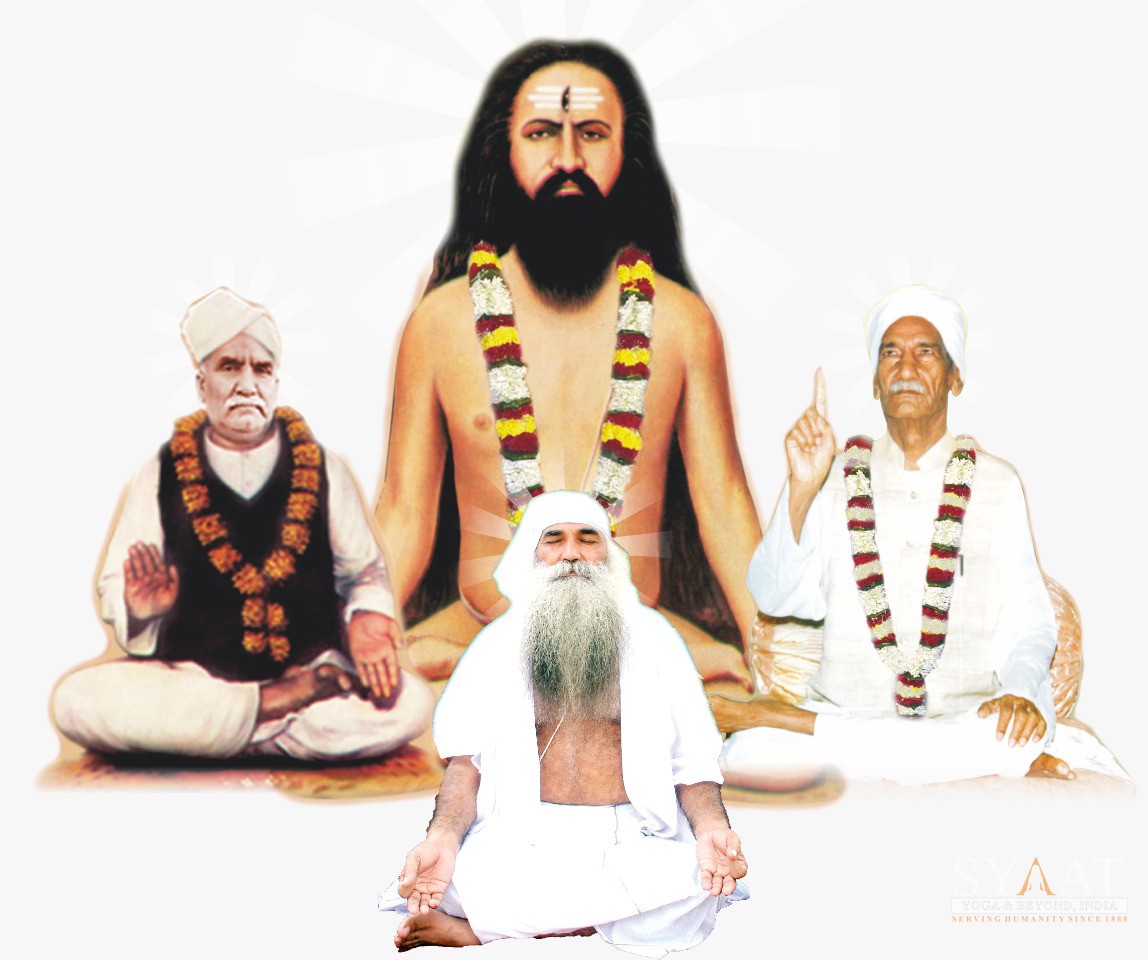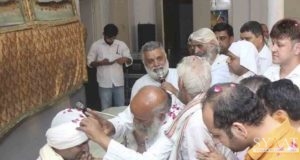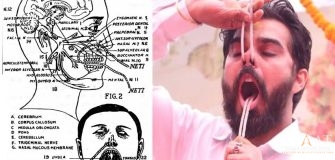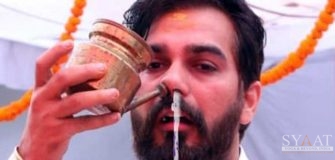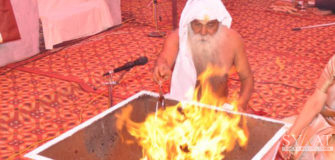Essence of Yoga
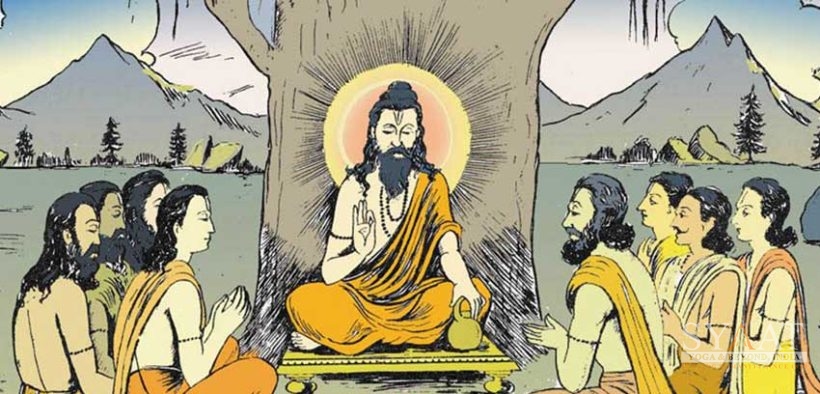
The human body is meant only for Ishwar Prapti(Realization of God) through Yoga Abhyas along with Guru Seva and His blessings.
The body is made of five Tatwas, viz. Prithvi (earth), Jala (water), Agni (fire), Vayu (air) and Akaash (sky). These Tatwas are characterised by different colours like yellow, green, red, etc. in subtle forms.
After getting initiation from Sadgurudeva, a Sadhaka while practicing Yoga sadhana with Guru kripa visualises these Tatwas in different colours. This is known as Tatwa Darshan. As a result of Tatwa Darshan he attains such a blissful state that his mind becomes introvert thereby loosing attraction towards the outer world gradually with the practice of Yoga.He is known to ba Tatwa Darshi Yogi. Such a Tatwa Darshi Yogi, with more practice, attains Aatam Darshan.
In addition to this, during the practice of yoga a few Sadhakas attain the state of Laya Yoga, which means to get observed in hearing various types of ‘naad’(sound) viz. ‘Anhad Naad’. Initially a Sadhaka, during the practice of Laya Yoga, hears the sound like that of chirping of birds and then gradually that of flute, ‘Veena’, Shanka, Gharial (celestial bell) and finally thundering of clouds, which is the complete state of Laya Yoga. He gets so much absorbed in hearing the divine sounds that no disturbance from the outer world can disturb him.
A few Sadhakas, during Dhyana, get holy darshans of Siddhas and gods and sometimes, the Siddhas and mahatmas, out of kindness, deliver upadeshas to Sadhakas.
Out of many types of Yoga, Shri Mahaprabhu Ram Lal Ji has given importance to only four types, viz., Mantra Yoga, Laya Yoga, Raja Yoga and Hatha Yoga. There are four classes of aspirants who possess right to learn one of the four types of Yoga. Only Poorna Yogi Guru, at the time of initiation, decides which class of aspirant should be initiated with what type of Yoga. Some of the Gurus of today initiate the Sadhakas with mantra without knowing about this. After getting initiation from Guru the Sadhaka leads his family life as before and no change is observed in his life. He remains absorbed only in one desire that he will attend the auspicious functions performed at the holy feet of his Guru, with offerings according to his devotion and then come back to his family life after getting ‘prasadam’ and blessings from his Guru. A few of the ‘Shishyas’(disciples), consequently, run a better business, a few get a better job, a few get child fortunately and so on. Thus, both Guru Shishya lead a life, full of happiness, but they cannot reach the ultimate goal of human life. Such Shishyas are incapable of attaining ‘dhyan Sthiti’ or a sight of divine light. Thus, becoming a prey to ‘Ahankara’ they lead their life without knowing their Guru and obeying his orders. It is also seen that gurus, who can neither exhibit the divine form nor provide divine power to the shishyas, cannot put influence on their disciples and disciples, too, do not obey their orders and discipline. On the basis of yoga practice in their previous births, the shishyas exhibit actions of lower stage like movement of head, lying on floor, jumping from the ground, but the Sthiti does not last for long and gradually disappears with time as their Guru is not a Poorna Guru.
As we find in scriptures, a practitioner of Dhyan Yoga should undergo processes of cleaning his inner bodily systems. Especially before pranayama some yogic kriyas are essential for ‘Naadi Shuddhi’. Pranayama is essentially needed to have control over the thought waves, the chitta-vrittis. The regular practice of Pranayama alongwith ‘Pranava Mantra’(Chanting of Guru Mantra in Prana) facilities in bringing the blissful union of ‘Praan’ and ‘Apaan’ Vaayu (Air). With regular practice of Pranayama the other three vaayus viz. Vyaan, Udaan and Samaan, join these two resulting in derivation of immense divine pleasure and ecstatic joy. He become free from all mental and bodily ailments. At this stage the yoga practitioner attains a ‘Nirodha Avastha’(state of control of Pranas), Pranava mantra prevails through the Pranas and ‘Hom’ is performed in ‘Nabhi’ by the Pranava Mantra. Such a phenomenon is termed as ‘Panch Bhutik Yagna’, about which Lord Krishna explains to Arjuna in Gita and which is a must for the Aatam Kalyan of the Jeevans on the earth. Thus, Sadhaka becomes free from all ignorance, doubts and impurities and become capable of getting the exact divine Darshans of Sat chit Anand ghan Prabrahma Sadguru Bhagwan. Then he knows his Guru and performs Seva to his Guru with all his devotion. As he practices yoga more and more alongwith worshipping his Sadgurudeva and offering services to his holy feet, he attains the goal of human life ultimately.
It is very essential to practise Yoga Sadhana regularly to know the right path. There is a ‘shloka’ in this context :
‘Yoga Karmasu Kaushalam’.
Meaning thereby that only through Yoga Abhyas we can do all the activities in our life with elegance. Once more ‘shloka’ about the importance of practice of yoga is :
‘Yogagni Dahitam khipram Paap Pinjaram’
Meaning thereby that Yogabhyas only can destroy all the evil deeds of our previous births done by the Jeeva. The evil deeds, otherwise, may prove hindrance in the path of yoga, hence, these evil deeds should be destroyed through Yogasbhyas.
Shri Mahaprabhu Ram Lal Ji says in front of Siddhas and Mahatamas :
‘Gyan nishtho Viraktova Dharmagyo api Jitendriya
Bina Yogen Devo Api Na Moksham Labhate Priye’.
Lord Shiva says-‘O dear Paarvati I one may attain Gyana (knowledge), Vairagya (detached from the world) he may have attained full control over his senses or many know all Dharma, but not even gods can attain ‘Moksha’ without practice and knowledge of yoga.’
Through Yogabhyas Sadhaka’s mind gets purified. When he does holy service to his Guru with such a pure mind he gains right to attain ‘Moksha’. If a Sadhaka does not purify his mind through yoga practice and does service to his Guru with such an impure mind, ‘Ahankar’, in subtle form, is created within him and he is unable to reach the ultimate goal of human life. An incident relating to Paras Nath, a disciple of Mahaprabhu Ram Lal Ji, may be cited here.
Paras Nath used to devote himself so much so, at the holy feet of Mahaprabhu Ram Lal Ji that no one could complete with him. He would carry out the orders of his Sadgurudeva in flick of a moment. For this he was considered as ‘Shiromani’ amongst Bhaktas and was held in high esteem by his Guru brothers and sisters.
On the other hand, our Sadgurudeva, Yogeshwar Mulakh Raj Ji Maharaj remained absorbed in Sri Mahaprabhu Ji’s Dhyanam, day and night all the 24 hours. He was always in blissful state (Turiyatituryaavastha) and sometimes he used to do service to his Sadgurudeva when he got up from Dhayanavastha. Once he was summoned by Shri Mahaprabhuji for the holy darshan at some hilly place. Yogeshwar Mulakh Raj Ji Maharaj, not caring for his cloths and outward appearance immediately set out for holy darshans of his Sadgurudeva. Just on beholding he prostrated at the holy feet of Mahaprabhuji and lost awareness of his body out of immense pleasure and remained prostrate for long. Parasnath, not knowing , the Garima of Dhyan Sthiti,laughed, and remarked at Yogeshwar Mulakh Raj Ji that he never does seva and lies just with eyes closed. Sri Mahaprabhuji remonstrating him said,’Paras’ ! Time will come when the Balaka, while standing in Akash, will work as savior to all the devotees in the hour of need and people like you will repent without attaining anyting.’after this incident the family members of Paras Nath came and took him alongwith an idea of getting him married. Since then Paras Nath was never seen in Guru Darbar.
To practise Dhyama Yoga a lonely good open airy, clean, greeny place with suitable climate and fearless environment, the bank of sacred river and moreover Saatvic Aahar is essential. In addition to this, ‘darshan’ and Sadupadesha of Guru and company of Yogabhyasis help a Sadhaka to attain the Stage of Dhyana.
For ‘Poornima Aatma Samarpan’ to his Sadgurudeva a Bhakta after getting initiation should practise to chant Guru Mantra in Prana all the time. He should practise Trataka to remove Drishti Dosha. He should practise ‘Khechari’ to remove avericiousness and should practise Shambhavi and Shanmukhi Mudra to wipe off all the Samkaras of previous births. Alongwith the regular practice of Yoga when he does service to his Sadgurudeva he, automatically attains the Siddhis of Yama and Niyama. Consequently , he attains Dhyanavastha. Attainment of ‘Paripakva’ Dhyanavastha leads him to state of ‘Samadhi’. This further leads him to Sanyas Avastha and he becomes free from Aadhi, Vyaadhi, Upadhi, which is the ultimate aim of human life. Divine incidents start happening in his life, due to which he develop devotion and unflinching faith like ‘Sumeru Parvat’ towards his Sadgurudeva. Now onwards, he seems to be Poorna Aatma Samarpit to his Sadgurudeva. All his activities become full of divinity. His mind, intellect and Prana remain absorbed all the time in the holy service and ‘Karya’(activities) of his Sadgurudeva alongwith the practice of Dhyan Yoga. All these above details are based on the principles of Shastras and the personal experience of Yoga practices of this Balak of Mahaprabhuji.


